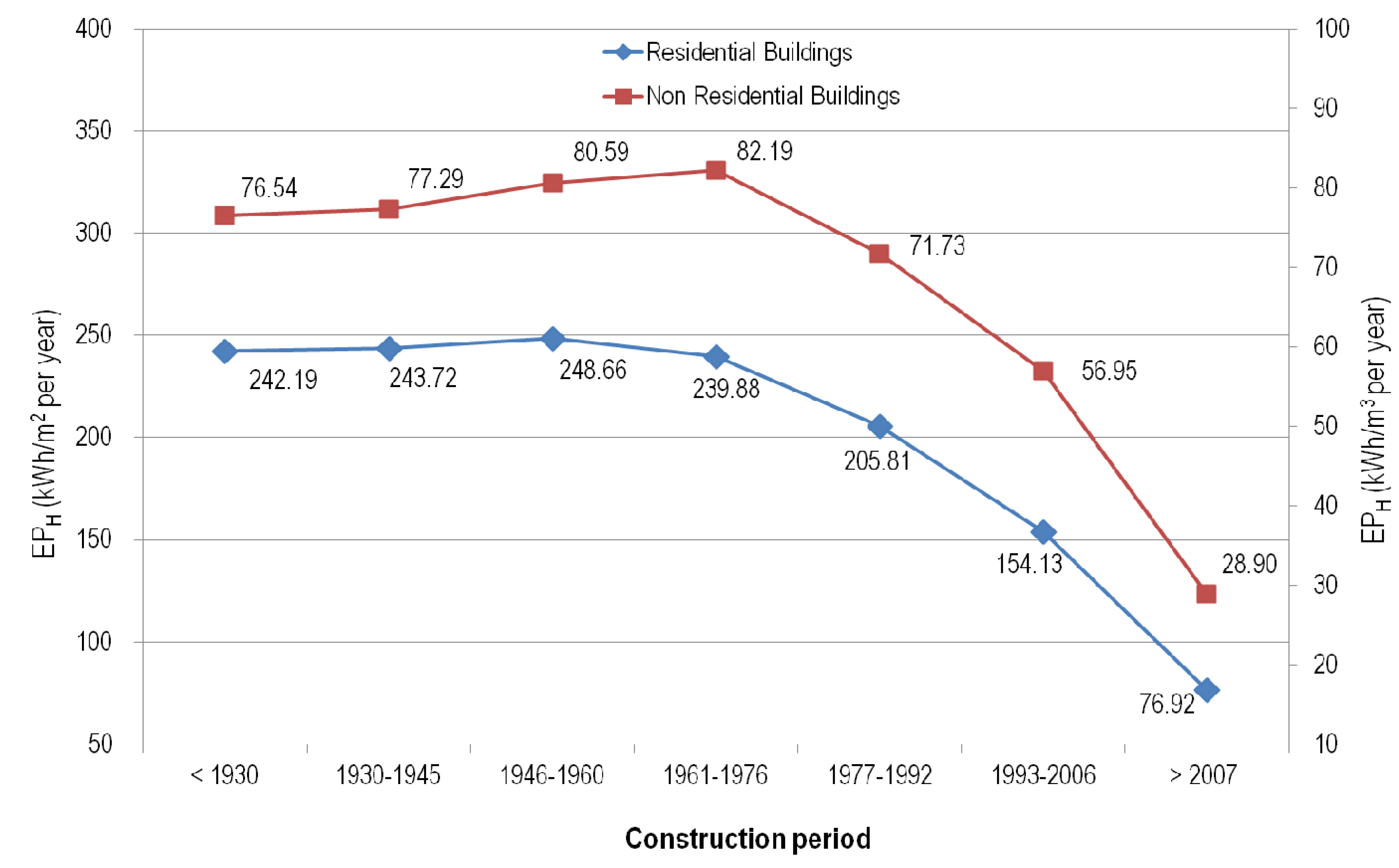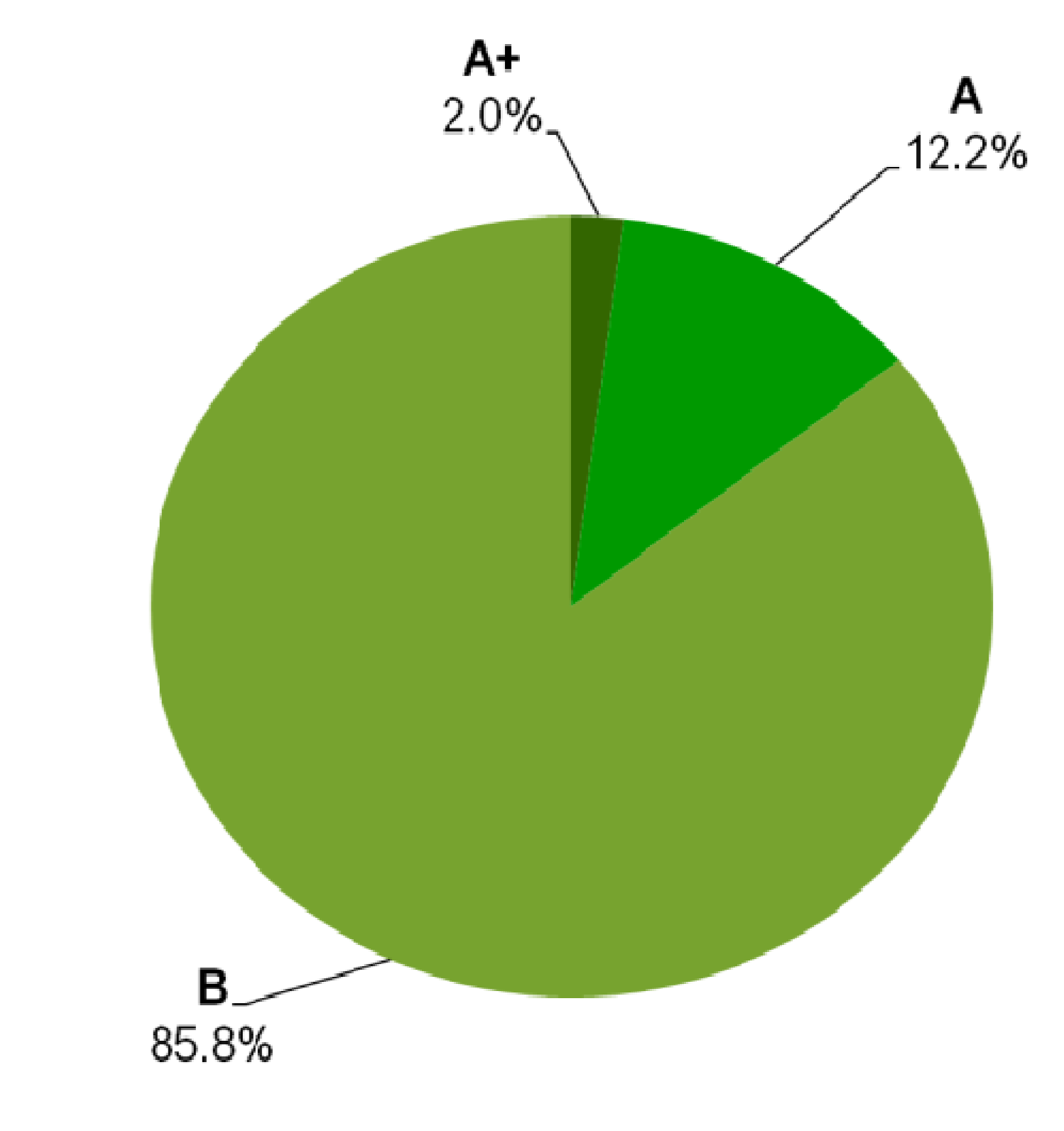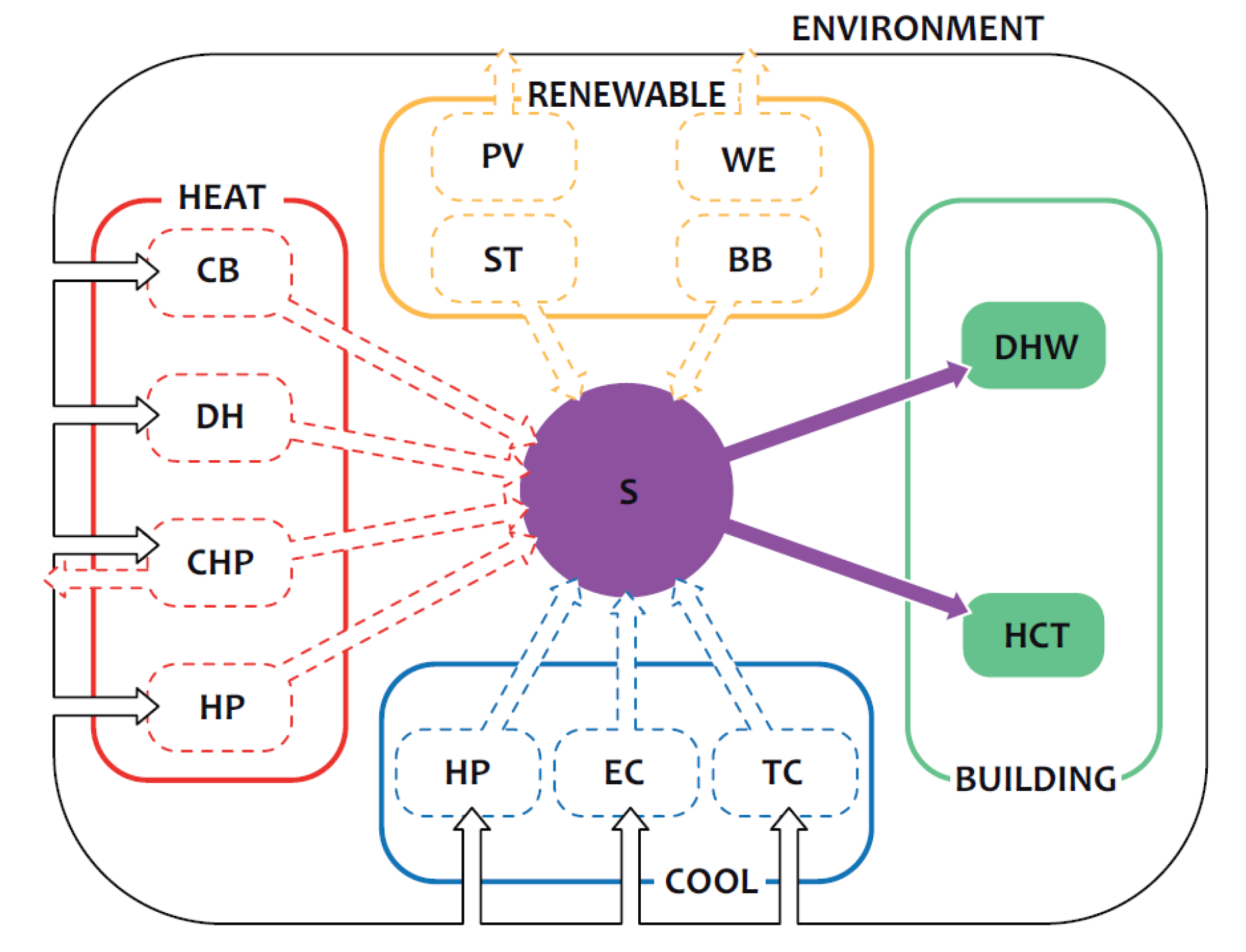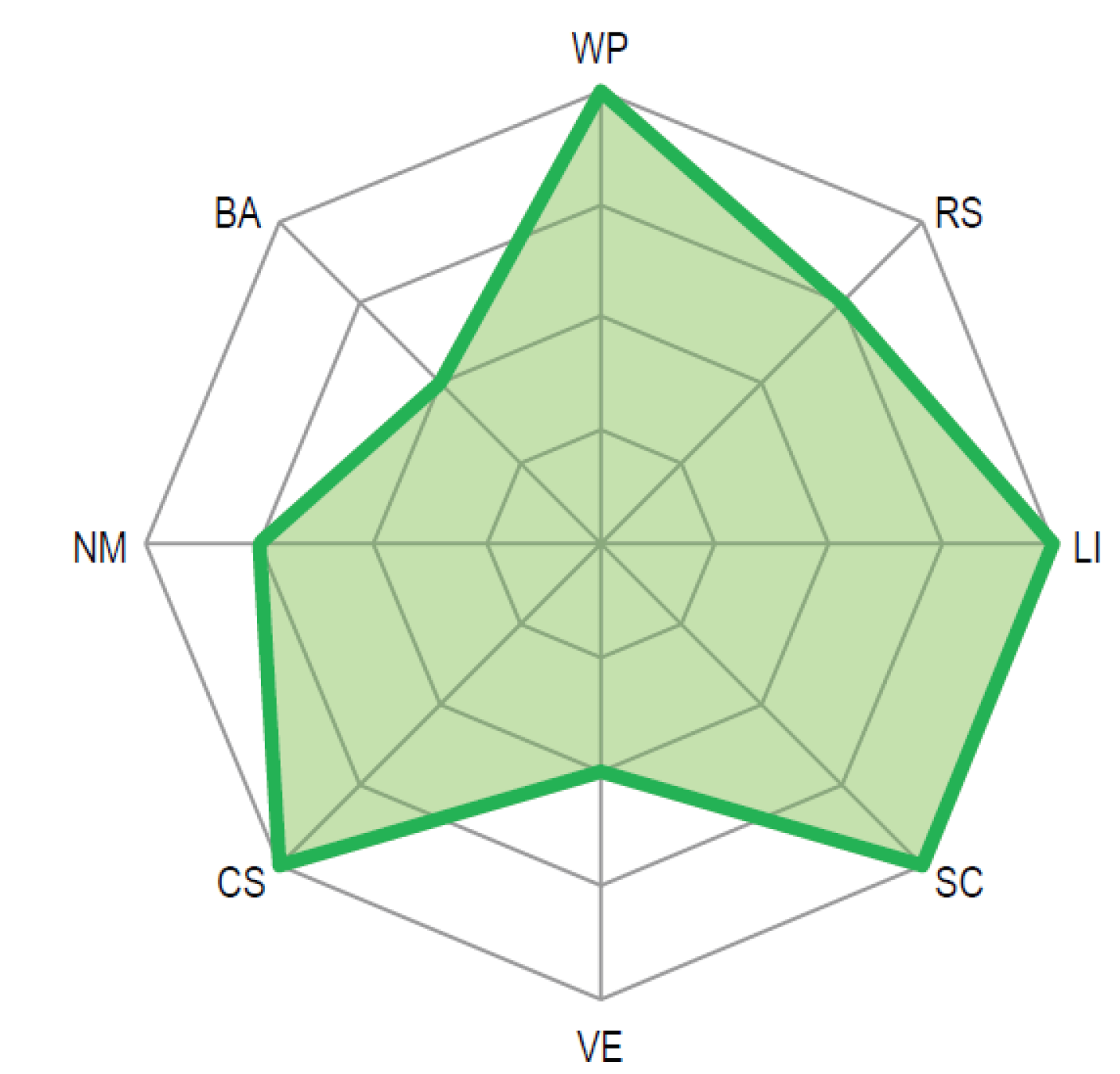Nearly Zero-Energy Buildings of the Lombardy Region (Italy), a Case Study of High-Energy Performance Buildings
Abstract
:1. Introduction
2. The Energy-Efficiency Building Policy in Lombardy Region
2.1. The Transposition of EPBD Directive
2.2. The Regional Accreditation Body
- -
- Providing accreditation for energy certifiers;
- -
- Creating and managing an cadastral energy register of buildings;
- -
- Developing a software that support calculation for energy certification of buildings;
- -
- Updating the calculation procedure used to determine a building’s energy performance, and the forms to be used as a part of the certification process;
- -
- Monitoring the impact of the provision for energy certification on end-users, in term of bureaucracy, cost and benefits;
- -
- Monitoring the impact of the provision for energy certification on the regional real estate market, as well as on builders, manufacturers of materials and components, and companies producing air conditioning systems or offering installation and maintenance services;
- -
- Providing scientific and technical advice in assistance to local and regional bodies and to certifiers within the region, in order to ensure the effectiveness and uniformity of the implementation of energy efficiency standards;
- -
- Adopting measures for the suspension and revocation of accreditation.
2.3. Calculation Procedure and Energy Classification Criteria
| Energy Class | Climatic Zone | ||
|---|---|---|---|
| E | F1 | F2 | |
| 2101 ≤ DDH <3000 | 3001 ≤ DDH <3900 | DDH > 3900 | |
| Residential buildings and similar (kWh/m2 per year) | |||
| A+ | EPH < 14 | EPH < 20 | EPH < 25 |
| A | 14 ≤ EPH < 29 | 20 ≤ EPH < 39 | 25 ≤ EPH < 49 |
| B | 29 ≤ EPH < 58 | 39 ≤ EPH < 78 | 49 ≤ EPH < 98 |
| Other buildings (kWh/m3 per year) | |||
| A+ | EPH < 3 | EPH < 4 | EPH < 5 |
| A | 3 ≤ EPH < 6 | 4 ≤ EPH < 7 | 5 ≤ EPH < 9 |
| B | 6 ≤ EPH < 11 | 7 ≤ EPH < 15 | 9 ≤ EPH < 19 |
3. Sustainable Construction in Lombardy, the Results of Change
| Energy Class | Non residential | Residential | Total | |||
|---|---|---|---|---|---|---|
| Nr of EPCs | % | Nr of EPCs | % | Nr of EPCs | % | |
| A+ | 106 | 0.01 | 931 | 0.10 | 1.037 | 0.11 |
| A | 523 | 0.06 | 5,914 | 0.65 | 6,437 | 0.71 |
| B | 2,436 | 0.27 | 42,901 | 4.71 | 45,337 | 4.98 |
| C | 11,269 | 1.24 | 57,060 | 6.27 | 68,329 | 7.51 |
| D | 19,673 | 2.16 | 74,509 | 8.19 | 94,182 | 10.35 |
| E | 18,002 | 1.98 | 91,022 | 10.00 | 109,024 | 11.98 |
| F | 19,422 | 2.13 | 102,281 | 11.24 | 121,703 | 13.37 |
| G | 64,070 | 7.04 | 400,020 | 43.95 | 464,090 | 50.99 |
| Total | 135,501 | 14.89 | 774,638 | 85.11 | 910,139 | 100.00 |

4. Nearly Zero-Energy Buildings
4.1. The Concept of a Nearly Zero-Energy Building
- -
- The energy performance of building envelopes improves considerably thanks to the more widespread use of insulation materials, plants, and shielding systems, all of which reduce thermal loads during both the winter and the summer;
- -
- Mainstream architecture has embraced the principles of bioclimatic architecture, which has gained increasing popularity (exploitation of the passive potential of buildings, direct gains, solar greenhouses, etc.);
- -
- Renewable energy sources (solar thermal, solar photovoltaic, biomass, wind, etc.) become the primary sources, and are used to their full potential;
- -
- Conventional energy sources are used merely to integrate building energy balances, and/or as a back-up;
- -
- Instead of a single generation system, more systems are installed and employed depending upon their convenience (e.g., solar thermal, biomass, heat pump, condensing boiler, inertial accumulation systems, etc.);
- -
- Exploiting the building’s thermal inertia allows planners to install lower power-capacity systems: the thermal inertia of the whole system can be increased by, for example, installing inertial storage tanks;
- -
- Buildings are no longer isolated in terms of systems, but instead become elements of a distributed, regional energy network: this approach allows the use of technologies (such as solar thermal or cogeneration systems) that can supply excess energy to the heating network (or excess electricity to the grid), contributing to the shift from centralized generation to distributed generation (which requires the implementation of smart energy infrastructures, such as smart grids);
- -
- Home automation becomes the most important tool to manage energy services in the best possible way.
4.2. High-Performance Buildings: Regione Lombardia’s Experience



5. Analysis of the Case Study
5.1. Description of the Methodology
5.2. Description of the Methodology
- -
- as a representative sample considering size, intended use and building typology;
- -
- Location within the territory of the Lombardy Region (considering different climatic conditions);
- -
- Disposition of the owners and designers, and availability of their personnel, to permit the necessary inspections.
- -
- Context and site;
- -
- Shape and function;
- -
- Energy choices;
- -
- Environmental choices.


6. Results and Discussion
| No. | Intended use | Location (Provence/County) | Energy Class | DDH (°C) | Construction period (year) | |
|---|---|---|---|---|---|---|
| Start | Completed | |||||
| 1 | Childcare centre | Milano | A+ | 2404 | 2008 | 2010 |
| 2 | Social housing | Brescia | A+ | 2420 | 2007 | 2009 |
| 3 | Residential building | Bergamo | A+ | 2467 | 2009 | 2011 |
| 4 | Residential building | Bergamo | A+ | 3000 | 2011 | 2012 |
| 5 | Social housing | Bergamo | A+ | 2479 | 2007 | 2009 |
| 6 | Social housing | Cremona | A+ | 2506 | 2010 | 2011 |
| 7 | Residential building | Milano | A+ | 2404 | 2010 | 2011 |
| 8 | Social housing | Brescia | A+ | 2399 | 2010 | 2012 |
| 9 | Residential building | Bergamo | A+ | 2543 | 2009 | 2010 |
| 10 | Nursery school | Milano | A | 2563 | 2007 | 2009 |
| 11 | Assisted living residence | Como | A | 2383 | 2009 | 2010 |
| 12 | School campus | Mantova | A | 2442 | 2008 | 2010 |
| 13 | Residential building | Brescia | A | 2229 | 2008 | 2011 |
| 14 | Residential building | Milano | A | 2404 | 2007 | 2011 |
| 15 | Residential building | Milano | A | 2404 | 2007 | 2011 |
| 16 | Residential building | Bergamo | A | 3433 | 2008 | 2010 |
| 17 | Residential building | Lecco | A | 2382 | 2007 | 2009 |
| 18 | Residential building | Lecco | A | 2383 | 2007 | 2011 |
| 19 | Residential building | Sondrio | A | 2758 | 2007 | 2011 |
| 20 | Social housing | Brescia | A | 2410 | 2009 | 2010 |
| No. | Gross volume (m3) | EPH (kWh/m2 per year) | S/V ratio (m−1) | Average U-values (W m-2K-1) | |||
|---|---|---|---|---|---|---|---|
| Walls | Roofs | Floors | Windows | ||||
| 1 | 3,258 | 2.90* | 0.50 | 0.19 | 0.17 | 0.20 | 1.12 |
| 2 | 6,817 | 12.70 | 0.56 | 0.21 | 0.18 | 0.21 | 2.05 |
| 3 | 2,567 | 10.42 | 0.64 | 0.12 | 0.11 | 0.17 | 1.10 |
| 4 | 2,537 | 6.43 | 0.55 | 0.15 | 0.10 | 0.20 | 0.93 |
| 5 | 2,310 | 8.70 | 0.62 | 0.13 | 0.10 | 0.18 | 1.24 |
| 6 | 28,183 | 7.32 | 0.46 | 0.22 | 0.19–0.22 | 0.12–0.21 | 1.40 |
| 7 | 3,228 | 8.9 | 0.57 | 0.16 | 0.19 | 0.14 | 1.40 |
| 8 | 4,636 | 1.13 | 0.58 | 0.15–0.24 | 0.10–0.07 | 0.18 | 0.85 |
| 9 | 789 | 0 | 0.60 | 0.18 | 0.18 | 0.25 | 1.10 |
| 10 | 10,337 | 5.85* | 0,57 | 0.16–0.20 | 0.30 | 0.23 | 1.30 |
| 11 | 21,489 | 4.70* | 0,40 | 0.32 | 0.16 | 0.32 | 1.3 |
| 12 | 9,400 | 5.90* | 0.63 | 0.11 | 0.20 | 0.15 | 1.40 |
| 13 | 15.390 | 21.72 | 0.60 | 0.26–0.39 | 0.29 | 0.43 | 1.47 |
| 14 | 3.948 | 26.68 | 0.36 | 0.23 | 0.32 | 0.34 | 1.50 |
| 15 | 10,172 | 25.84 | 0.51 | 0.25 | 0.28 | 0.33 | 1.65 |
| 16 | 207 | 34.60** | 0.84 | 0.18 | 0.14 | 0.20 | 1.40 |
| 17 | 1,267 | 17.84 | 0.58 | 0.20 | 0.21 | 0.23 | 1.70 |
| 18 | 7,870 | 28.99 | 0.47 | 0.28 | 0.24 | 0.29 | 1.3 |
| 19 | 3,805 | 21.31 | 0.67 | 0.21 | 0.23–0.24 | 0.23 | 1.24–1.31 |
| 20 | 5,237 | 16.76 | 0.52 | 0.26 | 0.16 | 0.27 | 1.80 |
| Building type | U-values of the building structures (W m−2K−1) | |||
|---|---|---|---|---|
| Walls | Roofs | Floors | Windows | |
| Mandatory minimum | 0.34 | 0.30 | 0.33 | 2.20 |
| Class A | 0.23 | 0.23 | 0.27 | 1.46 |
| Class A+ | 0.17 | 0.15 | 0.19 | 1.24 |
| No. | Heating system | Cooling system | Ventilation System | Solar thermal surface | Solar PV Peak power | ||||
|---|---|---|---|---|---|---|---|---|---|
| Type | HC (kW) | Terminals | Type | CC (kW) | Terminals | ||||
| (m2) | (kWp) | ||||||||
| 1 | GSHP | 59.1 | FRP | FCW | - | FRP | CMV | - | 14.8 |
| 2 | GSHP | 113.4 | FRP | GSHP | 113.4 | FRP | CMVE | 76.0 | 15.0 |
| 3 | AHP | 24.4 | FRP | AHP | 25.3 | FRP | CMV | 22.0 | 2.82 |
| 4 | GSHP | 52.3 | FRP | - | - | - | CMV | 2.34 | 1.15 |
| 5 | CB | 28.5 | FRP | AHP | 50 | AT | CMV | 13.9 | - |
| 6 | GSHP | 109.6 | FRP | - | - | - | CMV | - | - |
| 7 | AHP | 33.6 | FRP | AHP | 35.1 | FRP | CMV | - | 5.76 |
| 8 | AHP | 33.6 | AT | AHP | 27.6 | AT | CMV | - | 36.6 |
| 9 | GSHP | 20.0 | FRP | GSHP | 20.0 | FRP | - | - | 19.74 |
| 10 | GSHP | 105.9 | FRP | GSHP | 50.7 | FRP | CMV | - | 19.8 |
| 11 | GSHP | 114.6 | FRP | GSHP | 220 | FRP | CMVE | - | 19.6 |
| 12 | AHP | 156.1 | FRP | AHP | 141.5 | FRP | CMVE | 13.5 | - |
| 13 | GSHP | 8.2 | FRP | GSHP | 8.2 | FRP | CMV | 2.34 | 1.15 |
| 14 | GHP | 25.7 | FRP | - | - | - | - | 13.2 | 7.0 |
| 15 | GHP | 114.9 | FRP | - | - | - | - | 70.4 | 3.0 |
| 16 | AHP | 3 | FRP | - | - | - | CMV | - | 2.4 |
| 17 | CB | 90 | FRP | - | - | - | CMV | - | - |
| 18 | GSHP | 55.6 | FRP | GSHP | 42.7 | FRP-FCU | - | 18.0 | 13.8 |
| 19 | CB | 79.8 | FRP | - | - | - | - | 18.8 | - |
| 20 | DH | 93.5 | RAD | - | - | - | CMV | 30.8 | 5.8 |
| No. | Environmental and energy aspects | |||||||
|---|---|---|---|---|---|---|---|---|
| WP | RS | LI | SC | VE | CS | NM | BA | |
| 1 | 4 | 3 | 3 | 4 | 4 | 4 | 2 | 1 |
| 2 | 4 | 4 | 1 | 3 | 4 | 3 | 3 | 4 |
| 3 | 4 | 4 | 4 | 4 | 3 | 4 | 3 | 2 |
| 4 | 4 | 4 | 3 | 3 | 3 | 3 | 4 | 2 |
| 5 | 4 | 3 | 2 | 4 | 4 | 3 | 3 | 1 |
| 6 | 4 | 3 | 1 | 1 | 4 | 4 | 1 | 2 |
| 7 | 3 | 1 | 1 | 3 | 4 | 4 | 2 | 1 |
| 8 | 4 | 2 | 2 | 3 | 4 | 4 | 3 | 2 |
| 9 | 4 | 3 | 2 | 4 | 4 | 3 | 3 | 1 |
| 10 | 4 | 3 | 4 | 4 | 2 | 4 | 3 | 2 |
| 11 | 4 | 4 | 4 | 3 | 4 | 4 | 4 | 3 |
| 12 | 4 | 4 | 4 | 2 | 4 | 3 | 3 | 1 |
| 13 | 4 | 4 | 4 | 4 | 3 | 4 | 3 | 2 |
| 14 | 4 | 4 | 2 | 2 | 2 | 3 | 2 | 2 |
| 15 | 4 | 4 | 2 | 2 | 2 | 3 | 2 | 2 |
| 16 | 4 | 3 | 2 | 4 | 4 | 3 | 3 | 1 |
| 17 | 3 | 1 | 1 | 2 | 4 | 4 | 2 | 1 |
| 18 | 4 | 4 | 2 | 2 | 0 | 2 | 2 | 1 |
| 19 | 4 | 3 | 3 | 3 | 2 | 4 | 3 | 3 |
| 20 | 4 | 4 | 2 | 2 | 4 | 4 | 3 | 2 |
7. Conclusions
Abbreviations:
| AHP | Air to air Heat Pump |
| AT | Air Terminals |
| BA | Building/home Automation |
| BB | Biomass boiler |
| BEST | Building Environment Science and Technology |
| CB | Condensing Boiler |
| CEN | European Committee for Standardization |
| CENED | Certificazione Energetica degli Edifici |
| CESTEC | Centre for Technological Development, Energy and Competitiveness |
| CHP | Combined Heat and Power |
| CS | Conscious in context and site |
| DH | District Heating |
| DHW | Domestic Hot Water |
| EC | Electric Chiller |
| EP | Primary Energy |
| EPBD | Energy Performance Building Directive |
| EPC | Energy Performance Certificate |
| FCU | Fan Coil Units |
| FCW | Free Cooling with hot Water |
| FRP | Floor Radiant Panels |
| GB | Green Building |
| GHP | Gas fired Heat Pump |
| GPD | Gross domestic product |
| GSHP | Ground Source Heat Pump |
| HP | Hat Pump |
| HTC | Heating Cooling Terminals |
| LI | Conscious Lighting design |
| NM | Use of Natural Materials |
| PV | Photovoltaic solar |
| RAB | Regional Accreditation Body |
| RET | Renewable Energy Technologies |
| RS | Renewable energy Sources |
| S | Storage |
| SC | Conscious in Summer comfort design |
| TC | Thermal fired Chiller |
| TS | Thermal Solar |
| VE | Conscious in Ventilation design |
| WP | Winter energy Performance |
| ZEB | Winter energy Performance |
Conflict of Interest
References
- Commission of the European Communities. Green Paper: A European Strategy for Sustainable, Competitive and Secure Energy; European Commission: Brussels, Belgium, 2006. [Google Scholar]
- Council of the European Union. Energy Performance of Buildings; Directive 2002/91/EC of the European Parliament and of the Council of 16 December 2002; Council of the European Union: Brussels, Belgium, 2002. [Google Scholar]
- Council of the European Union. Energy Performance of Buildings (Recast); Directive 2010/31/EU of the European Parliament and of the Council; Council of the European Union: Brussels, Belgium, 2010. [Google Scholar]
- Regulations for Energy Consumption Control for Buildings Heating; Ordinary Law of the Parliament No. 373 of 04/30/76; Italian Official Gazette: Rome, Italy, 1976.
- Rules for the Implementation of the National Energy Plan in the Field of Rational Use of Energy, Energy Conservation and Development of Energy Renewable Sources; Law No. 10 of 01/09/91; Italian Official Gazette: Rome, Italy, 1991.
- Implementation of Directive 2002/91/EC on the Energy Buildings Performance; Legislative Decree No. 192 of 08/19/05; Italian Official Gazette: Rome, Italy, 2002.
- Corrective and Supplementary Provisions to the Legislative Decree 19 August 2005, N. 192. Implementing Directive 2002/91/EC on the Energy Performance of Buildings; Legislative Decree No. 311 of 12/29/06; Italian Official Gazette: Rome, Italy, 2007.
- The International Energy Agency’s Solar Heating & Cooling Programme Web Page. SHC Task 40—Annex 52 towards Net Zero Energy Solar Buildings Project. Available online: http://task40.iea-shc.org/ (accessed on 5 May 2013).
- Marszal, A.J.; Bourrelle, J.S.; Musall, E. Net Zero Energy Buildings and Calculation Methodologies versus National Building Codes. In Proceedings of EuroSun 2010 International Conference on Solar Heating Cooling and Buildings, Graz, Austria, 28 September–1 October 2010.
- Marszal, A.J.; Heiselberg, P.; Bourrelle, J.S.; Musall, E.; Voss, K.; Sartori, I.; Napolitano, P. Zero energy building—A review of definitions and calculation methodologies. Energy Build. 2011, 43, 971–979. [Google Scholar] [CrossRef]
- Engelund, T.K.; Wittchen, K.B. European national strategies to move towards very low energy buildings. In European Alliance of Companies for Energy Efficiency in Buildings; Danish Building Research Institute: Copenhagen, Denmark, 2008. [Google Scholar]
- Principles for Nearly Zero Energy Buildings; Buildings Performance Institute Europe: Brussels, Belgium, 2011.
- Dall’O’, G.; Bruni, E.; Sarto, L. An Italian pilot project for zero energy buildings: Towards a quality-driven approach. Renew. Energy 2013, 50, 840–846. [Google Scholar] [CrossRef]
- Annunziata, A.; Frey, M.; Rizzi, F. Towards nearly zero-energy buildings: The state-of-art of national regulations in Europe. Energy 2013, in press. [Google Scholar] [CrossRef]
- Popescu, D.; Bienert, S.; Schutzenhofer, C.; Boazu, R. Impact of energy efficiency measures on the economic value of buildings. Appl. Energy 2012, 89, 454–463. [Google Scholar] [CrossRef]
- Chan, E.H.W.; Qian, Q.K.; Lam, P.T.I. The market for green building in developed Asian cities—the perspectives of building designers. Energy Policy 2009, 37, 3061–3070. [Google Scholar] [CrossRef]
- Li, D.H.W.; Yang, L.; Lam, J.C. Zero energy buildings and sustainable development implications—A review. Energy 2013, 54, 1–10. [Google Scholar] [CrossRef]
- Regulations for the Prevention and Reduction of Air Emissions to Protect the Health and the Environment Web Page. Regional Law No. 24 of 12/11/06. Available online: http://goo.gl/N3sHg (accessed on 5 May 2013).
- Determinations Regarding the Energy Buildings Certification, in Implementation of Legislative Decree No. 192/05 and Art. 9:25 of Regional Law No. 24/06 Web Page. Regional Council Decree No. VIII/5018 of 06/26/07. Available online: http://goo.gl/3qclu (accessed on 5 May 2013).
- Energy Buildings Certification-Amendments and Additions to Regional Council Decree No. VIII/5018 Web Page. Regional Council Decree No. VIII/5773 of 10/31/07. Available online: http://goo.gl/O7DMK (accessed on 5 May 2013).
- Determinations Regarding the Provisions for Buildings Energy Efficiency and for Buildings Energy Certification Web Page. Regional Council Decree No. VIII/8745 of 12/22/08. Available online: http://goo.gl/iDuUe (accessed on 5 May 2013).
- Provisions Relating to the Environment and Services of General Economic Interest Web Page. Regional Law No. 10 of 06/29/09. Available online: http://goo.gl/dufjH (accessed on 5 May 2013).
- Updating of the Procedure for Calculating the Energy Certification of Buildings Web Page. Director General Decree No. 5796 of 06/11/09. Available online: http://goo.gl/79FOS (accessed on 5 May 2013).
- Policy Address, Method of Investigation of Offenses and Sanctions Imposition of Regional Competence, Provided by Art. 27 of Law No. 24, in the Field of Energy Certification Web Page. Regional Council Decree No. IX/2554 of 11/24/11. Available online: http://goo.gl/JRfoZ (accessed on 5 May 2013).
- Energy Cadastre of Lombardy Region Web Page. Finlombarda. Available online: http://www.cened.it/ceer (accessed on 16 July 2013).
- Centre for Technological Development, Energy and Competitiveness (CESTEC Lombardy Region). Lombardia A+, Nearly Zero-Energy Buildings in Lombardy; Edizioni Ambiente: Milano, Italy, 2012. [Google Scholar]
- Dall’O’, G.; Sarto, L.; Galante, A.; Pasetti, G. Comparison between predicted and actual energy performance for winter heating in high-performance residential buildings in the Lombardy region (Italy). Energy Build. 2012, 47, 247–253. [Google Scholar] [CrossRef]
- Dall’O’, G.; Sarto, L.; Sanna, N.; Martucci, A. Comparison between predicted and actual energy performance for summer cooling in high-performance residential buildings in the Lombardy region (Italy). Energy Build. 2012, 54, 234–242. [Google Scholar] [CrossRef]
- CENED Photogallery Web Page. Finlombarda. Available online: http://www.cened.it/photogallery_cened (accessed on 17 July 2013).
© 2013 by the authors; licensee MDPI, Basel, Switzerland. This article is an open access article distributed under the terms and conditions of the Creative Commons Attribution license (http://creativecommons.org/licenses/by/3.0/).
Share and Cite
Dall'O', G.; Belli, V.; Brolis, M.; Mozzi, I.; Fasano, M. Nearly Zero-Energy Buildings of the Lombardy Region (Italy), a Case Study of High-Energy Performance Buildings. Energies 2013, 6, 3506-3527. https://doi.org/10.3390/en6073506
Dall'O' G, Belli V, Brolis M, Mozzi I, Fasano M. Nearly Zero-Energy Buildings of the Lombardy Region (Italy), a Case Study of High-Energy Performance Buildings. Energies. 2013; 6(7):3506-3527. https://doi.org/10.3390/en6073506
Chicago/Turabian StyleDall'O', Giuliano, Valentina Belli, Mauro Brolis, Ivan Mozzi, and Mauro Fasano. 2013. "Nearly Zero-Energy Buildings of the Lombardy Region (Italy), a Case Study of High-Energy Performance Buildings" Energies 6, no. 7: 3506-3527. https://doi.org/10.3390/en6073506




